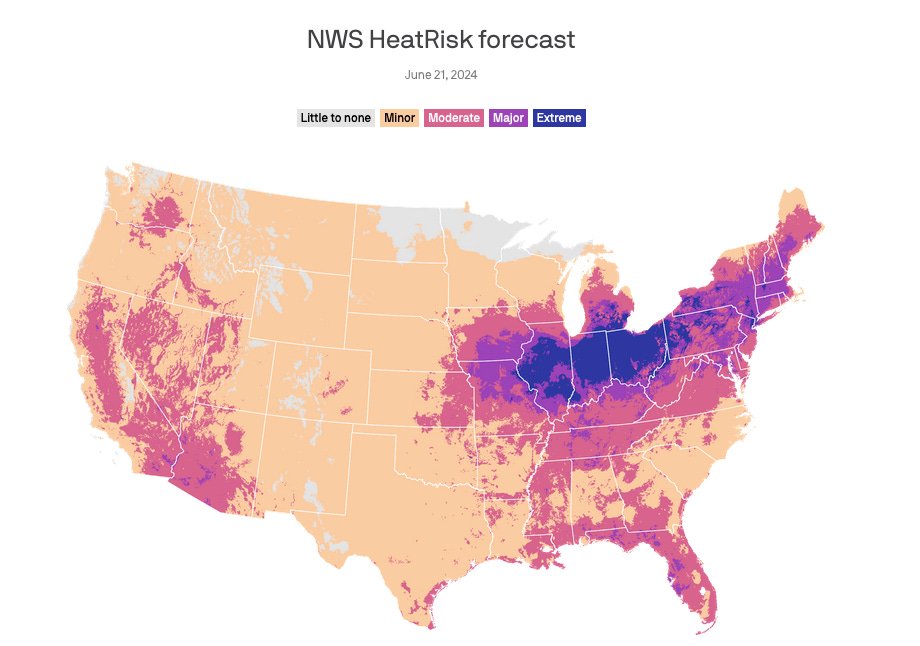Let's Stop Talking About Heat Domes. Instead, Let's Do Something About Them.
Publisher’s Notes
The dominant topic of every small talk and quaint conversation in between jumps through tree-lined shade and, if you’re among the fortunate, into air-conditioned spaces is the heat. As most of us have noticed, suffering under oppressive temperatures in the aptly-termed “heat dome,” it is awful hot and dry throughout much of the United States. As ABC News reports …
More than 60 million Americans from coast to coast are under heat alerts as the life-threatening heat dome continues for the second week.
The Northeast, Southeast and West all saw daily record temperatures shattered this weekend, including 98 degrees in Philadelphia; 100 degrees in Greenville, Mississippi; and 108 degrees in Merced, California.
This weekend, Washington, D.C., and Baltimore hit 100 degrees for the first time in June in 12 years.
On Monday, the dangerous heat is impacting the Southeast, the Deep South and the West. Temperatures are forecast to soar to 96 degrees in Atlanta; 94 degrees in New Orleans and Nashville, Tennessee; 100 degrees in Little Rock, Arkansas; 99 degrees in Oklahoma City; 98 in Dallas; 109 in Phoenix; 97 in Salt Lake City; and a blistering 110 in Las Vegas and Palm Springs, California.
The problem is not so much the heat (since, with climate crisis bearing down on us, we should expect much more of it as we allow more fossil fuel use) - it’s the way we address it, or don’t address it. As dangerous as it is, the public habit is to treat it as just another weather event that is outside of our control. Meteorologists, reporting on these events, add to that laissez-faire approach by not acknowledging or mentioning climate crisis. Local and state elected officials and policymakers absolve themselves of any responsibility by resorting to a hands-thrown-in-the-air model of non-leadership, with governments simply issuing “Code Red” alerts and heat advisories and advice on how much water to consume throughout the day and what to do in the event of a heat stroke.
But this is all after the fact: we’re already in the throes of the heat and the climate crisis is here to stay. That leads to a level of unnecessary public demoralization and detachment. Which is why we need a new heat strategy …
Talk before, not during and after. It’s critical for advocates, policymakers and media to remind the general public that - see - we do need to talk about deadly heat waves all year round and not wait till they're right on us. Let's get urgent about heat waves, let's stop dismissing them as another hot day and let's implement solutions for them now.
Stop with the heat jokes. We also need to set a tone of urgency: heat waves, heat domes and urban heat islands are all dangerous and deadly. The public discourse, policymakers and meteorologists need to stop cutting jokes about "how hot it is." The public conversation must stop desensitizing us to heat waves.
Make the connection. News media must make an incessant and firm connection between heat waves and climate crisis. At the moment, it's failing to do that and the heat-generating fossil fuel industrial complex is winning and creating more deadly global heat domes.
Yes, that’s correct: heat domes can be removed. The most effective way to manage and battle heat waves is by, well, 1) simply eliminating fossil fuel usage and transitioning to a complete clean energy grid, but even more immediate and cheaper: 2) building robust heat infrastructure. We need to put demands on policymakers and markets to do just that because the money, technology and innovations are there.
Heat infrastructure is smart surface solutions. Mass scale deployment of smart surface solutions is easy: community solar on every available roof. Reflective “cool roofs” on every residential and commercial building. Reflective sidewalks and street pavements everywhere. Transforming every available vacant lot into an urban garden and park oasis. Planting tree canopy in every available. These strategies are proven to rapidly cool down cities and metropolitan regions. They are all inexpensive, immediate, and they result in less health, crime and economic stress on individuals, families and entire communities.
Time to acknowledge heat inequity … and call it for what it is: systemic racism. We need to educate the public on how heat wave impacts are being felt differently and more dangerously according to the zip codes people live in. Black and Brown populations keep being stuck or confined to neighborhoods where it’s hotter due to lack of tree canopy and access to heat mitigation solutions and cooler technology and, of course, higher inability to pay for rising energy costs from desperate air conditioning use.
So then, put the stress on policymakers. Policymakers/elected officials are getting off the hook for failed heat stress strategies and failing to address heat inequity by simply relying on "Code Red" alerts and bumping up funding for weatherization funds and LIHEAP (Low Income Home Energy Assistance Program) for high energy bills after increased AC usage. This is reactive: so, no, the “paradigm shift in how we respond to extreme heat,” as energy economist Mark Wolfe put it in a recent CNN column is not an almost singular focus on energy bills. That conversation, in many ways, continue to place the responsibility of heat stress response on communities. Instead, policymakers and communities could be very proactive in deploying the smart surface solutions outlined above.
Make heat a voting issue. In an election year, being better prepared for heat waves, building heat infrastructure and finally deploying solutions is all at stake. If you don't want to die from the heat, well then vote for the candidates and policymakers who are actually working on and investing in the heat wave and climate crisis solutions.




